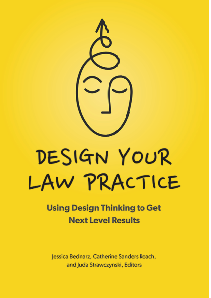Book Review: Design Your Law Practice: Using Design Thinking To Get Next Level Results. Jessica Bednarz, Catherine Sanders Reach and Juda Strawczynski, Editors. (American Bar Association 2023). Available direct from the publisher or via Amazon.
Normally if I saw a word like “ideate” in a table of contents I would not even think about buying or reading that book. I don’t have time to invest in things that read like a bloviated Ph.D. thesis. If I had followed my usual rule I would have missed out on one of the more interesting and useful books I have read for some time.
 I decided to break my rule and buy this book because I saw among the authors several known to me to be original thinkers and good writers, including Catherine Sanders Reach, Jack Newton, Jim Calloway and Greg Siskind. After reading the book I’m adding most of their co-authors to my must-follow list.
I decided to break my rule and buy this book because I saw among the authors several known to me to be original thinkers and good writers, including Catherine Sanders Reach, Jack Newton, Jim Calloway and Greg Siskind. After reading the book I’m adding most of their co-authors to my must-follow list.
If you are like most lawyers you have never heard of “design thinking.” Not to feel bad. Neither did Greg: “I never knew the term ‘design thinking’ until just a few years ago when I attended a legal technology conference. … What I heard made me realize that I had been incorporating design thinking into my practice for decades and never knew there was a whole body of knowledge on the subject.”
Having been fortunate enough to read this book I proffer the following explanation:
Design thinking is a systematic approach to rethinking your business approach with the goal of finding and implementing major beneficial changes. Check out the Harvard Business School definition. At least some sophisticated organizations are beginning to appreciate the potential for large benefits.
For lawyers, a large part of design thinking is usually changing from “thinking like a lawyer” to “thinking like a client.” As the influential British apostle of innovation Richard Susskind has pointed out, clients don’t want a hammer. They want a chair. Susskind, Transforming the Law (Oxford University Press 2003).
Why do I like this book? Let me count the ways:
- Jack Newton, author of the influential book The Client-Centered Law Firm, lived up to his reputation for innovative thinking, delivered in concise and well written prose. Newton’s best insights are in Chapter 1, “Empathize: Research Your Client’s Needs.”
- The emphasis on case studies, lived experience. Greg Siskind’s chapter about his immigration law practice was particularly compelling. Greg is the most creative lawyer I have known in 40 years of practicing law and his experiences are relevant not just to immigration lawyers, but anyone interested in innovation and its handmaiden, making money.
- The emphasis on empathy. You must resolve the conflict between “Thinking like a lawyer” and “Thinking like a client” wisely.
- The last 21 pages of the book, which provide invaluable worksheets and checklists. The ABA provides some high-quality lagniappe; some of these tools are available from the ABA website at no charge.
No book is perfect. My number one quibble with this one is the occasional appearance of impenetrable jargon. One example: despite a few Google searches I’m still not certain about the meaning of the phrase “white label software” (p. 94). Given the book’s value this is a forgivable sin.
Bottom Line: Any law firm or lawyer interested in innovation that will make their practice more profitable and attract more clients will benefit from this book.
